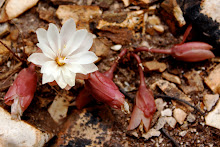Central Oregon, by comparison, sports frozen ground for part of the winter and extremely dry summers. We're only two inches of precipitation per year away from being an actual desert. Needless to say, moving from the doorstep of the Chesapeake Bay to a land that only sees a few violent thunderstorms' worth of rain per the three-month (and that's a pretty strict three months) summer was a shock to my system. I resented the gray-green of juniper and even the tall, majestic ponderosas that dominate the landscape. Even though they're completely different plants, the sagebrush, rabbitbrush, and bitterbrush all rolled together; a family of mid-sized shrubs that hurt if you brushed up against them and seemed to hold less nutrition for wildlife than the volcanic ash that covers the ground. The soil is dead, there's no water, and there are about five dominating plant species.
It was hard in the beginning. But I found that this year my love for the sagebrush steppe's plant community flourished because of one saving grace that managed to speak my language in a way I hadn't expected: wildflowers.
Splashes of blue, pink, red, and yellow against the sandy, gray ash tugged at my spirit until I realized that these tiny fireworks of vitality would not only save me from the painful disconnect I've felt from the floral community, but would teach me about survival in an unforgiving landscape.
My forests of home are mixed deciduous forests of beech, birch, tulip poplar (not a poplar at all, but such a beautiful name I can't discontinue its use), black walnut, and oak. Hidden pockets of ironwood enticed me to run my hands along sinewy branches, taut like the muscles of a young man in his prime. The breathtaking orange and yellow tulip-like flowers that gave Liriodendron its common name, which, when disturbed or spent, float to the forest floor from stories above like a floral rain. Magnolia trees stand not-so-tall so you can push your face into their huge, white, fantasy blooms. Grape vines hang, rose canes reach, raspberries secretly develop their drug-like drupelets.
The ponderosa forest is a very different one. For one thing, it's been around for hundreds of years; it was never leveled to create farmland, then replanted (or left to become a forest once more). These "ponderous" pines, at least some of them, have been growing for centuries. Granted, most of the old growth is limited because ponderosa is one of the leading lumber-woods in North America, but these Standing Ones are relentlessly impressive. Below them, depending on elevation, grows bitterbrush or manzanita. Before the invention of the US Forest Service, small or medium wildfires moved through, burning out most of the understory, leaving large, park-like grassy meadows between the sentient trees. Thanks to the shortsightedness of the people that took over this land, wildfires were halted for a good 60 years. For the ecosystem, that meant more underbrush, taller underbrush, and fewer pine trees which depend on intense heat to open cones and signal seeds. Wildfires, when they start from lightning strikes, now climb up the understory and into the trees. If the fire reaches the "crown," or top of the tree, the tree dies. The burning of matter on the ground replenished the soil and encouraged fleshy plants to grow, supporting wildlife.
Shortsighted man, once more, had produced exactly the opposite of what he'd meant to do. Now, because fires are completely stomped out instead of being allowed to burn, they're hotter, more intense, do more damage, and take the lives of firefighters and homes of civilians every year. Stifling fire allowed understory to explode which means more stuff to burn.
So, this is a forest that needs a haircut. Despite the legacy that the innocent Smoky Bear left behind, I have learned to love this forest of sand and little water. The shade is cool. The flickers are loud. The lizards are lightning-fast. And the wildflowers, against all odds, produce explosions of color and shape. Sulphur Buckwheat has round leaves low to the ground and literally neon-yellow umbels on tall stalks. Purple penstemon that bleeds into blue rise above the ground and seduce pollinators. Oregon Sunshine stands in yellow bunches, while Paintbrush rises delicately with its feathery red plumes lifting towards the sky. Globemallow is almost a dream, a confusion of red and orange blossoms on long green stalks that float above the parched earth.
And Bitterroot, of all, a flower that bears so little leaf that it's easy to miss altogether. White or pink blooms sitting on the ground with fleshy roots that served as food for the local First Tribes. These creatures became my salvation: when I find them, it's always a surprise. I stand and marvel, lay on my belly and gently stroke their petals, examine their throats for bees, take photo after photo. And, sometimes, they give me something besides beauty: two mornings ago I took the dog for a walk in the forest and a mosquito bite was driving me crazy. I found some yarrow, chewed a small piece of its minty, sticky leaf, and applied the poultice to the bite. It immediately stopped itching and shrunk down. Today, it's gone. I left a few strands of my hair on the plant to show my respect.
It's taken a long time, but the dry heat of the summer sun, the towering snow-capped mountains, and the perpetual surprise of wildflowers have finally tied this landscape into my heart.
Even the cactus, resented for its ability to stab, produces a profusion of beauty in the summertime. Creamy yellow flowers open unexpectedly on the fleshy green pads, amidst the long, sharp spines. A desert rose, to be sure.






No comments:
Post a Comment